Left Eye Sight Weak: Causes and Treatment Solutions
Left Eye Sight Weak: Causes and Treatment Solutions
Feeling like your left eye vision is weak can really worry you. It can make everyday tasks harder and affect your life quality. Knowing why it happens and what you can do about it is key to keeping your eyes healthy. In this article, we’ll look at why your left eye might not be seeing well, the medical issues behind it, and how to get your vision back.
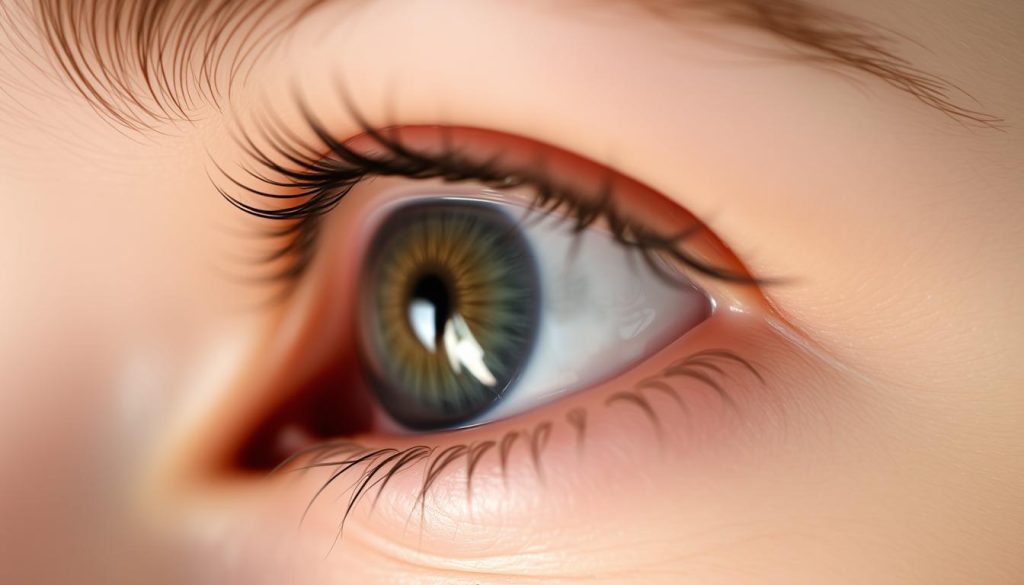
Key Takeaways
- Understand the common symptoms of left eye vision weakness, including blurred vision, difficulty focusing, and reduced depth perception.
- Recognize the impact of left eye vision problems on daily activities such as driving, reading, and computer work.
- Identify the medical conditions and neurological factors that can contribute to left eye sight weakness.
- Learn about the various diagnostic tests and professional eye examinations used to assess and identify the underlying causes.
- Explore the range of medical treatment options, natural remedies, and eye exercises that can help improve left eye vision.
Understanding Left Eye Vision Problems: An Overview
Having vision issues in the left eye can worry you. It can make everyday tasks hard. Knowing the signs and when to see a doctor is key.
Common Symptoms of Left Eye Vision Weakness
- Blurred or distorted vision in the left eye
- Difficulty with depth perception and judging distances
- Increased eye strain and fatigue
- Sensitivity to light and glare
- Headaches or dizziness related to visual impairment
Impact on Daily Activities
Left eye vision problems can make daily tasks tough. People may find it hard to read, drive, or move around. This weakens their vision and spatial sense, posing safety risks.
When to Seek Medical Attention
If your left eye vision problems get worse or don’t go away, see an eye doctor. Severe eye pain, sudden vision loss, or sudden changes in vision need quick attention. They could be signs of a serious issue.
“Addressing left eye vision problems early on can help prevent further deterioration and improve overall quality of life.”
Left Eye Sight Weak: Medical Conditions and Causes
Many eye problems can make the left eye weaker. Amblyopia, or “lazy eye,” is a common one. It happens when the brain prefers one eye over the other, making the weaker eye less clear.
Cataracts can also weaken the left eye. They are when the eye’s lens gets cloudy, blocking light and vision. Glaucoma, with its high eye pressure, can harm the optic nerve and affect vision.
Retinal detachment is another serious issue. It’s when the retina pulls away from the eye’s back. This can cause sudden, severe vision loss and needs quick treatment to avoid lasting damage.
| Ocular Disorder | Description | Impact on Left Eye Vision |
|---|---|---|
| Amblyopia (Lazy Eye) | Developmental disorder where the brain favors one eye over the other | Reduced visual acuity in the weaker eye |
| Cataracts | Clouding of the eye’s natural lens | Obstruction of light reaching the retina, impairing vision |
| Glaucoma | Increased fluid pressure within the eye, damaging the optic nerve | Vision problems, including potential vision loss |
| Retinal Detachment | Separation of the retina from the back of the eye | Sudden and severe vision loss in the affected eye |
Knowing what causes left eye weakness is key to fixing it. With the right diagnosis and treatment, many people can improve their eye health and vision.
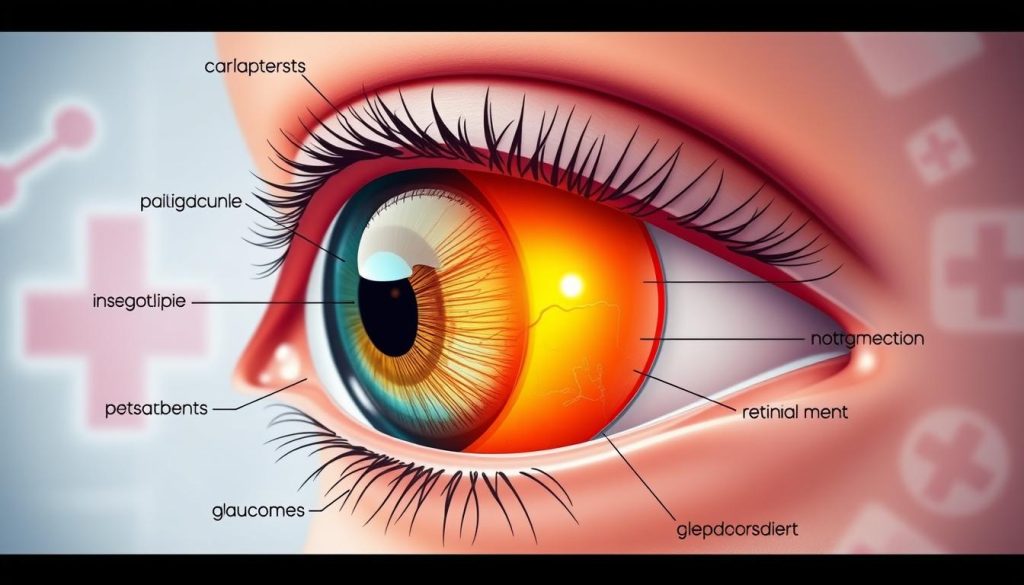
The Role of Neurological Factors in Vision Problems
The brain is key in dealing with visual impairment and eye health. It works closely with the eyes to keep our vision sharp. This connection is vital for good vision problems.
Brain-Eye Connection
The brain and eyes form a team. The eyes capture images, and the brain makes sense of them. The optic nerve carries these signals to the brain’s visual center.
Nerve Pathways and Visual Processing
- The optic nerve sends visual info from the retina to the brain.
- The brain’s visual cortex interprets and processes this data.
- Damage to these pathways or centers can cause vision problems, like weakness in the left eye.
Neurological issues, like brain injuries or strokes, can mess with how the brain handles vision. This can lead to visual impairment. It’s important to understand how the brain and eyes work together for eye health.
Common Eye Disorders Affecting Left Eye Vision
The left eye can face many vision problems. It’s important to know about these issues to keep your eyes healthy. Let’s look at some common conditions that can affect your left eye.
Strabismus: Misaligned Eyes
Strabismus, or crossed eyes, happens when eyes don’t line up right. It can cause double vision and eye strain. It’s often due to muscle or nerve problems and can hit the left eye harder.
Optic Neuritis: Inflammation of the Optic Nerve
Optic neuritis is when the optic nerve gets inflamed. It can lead to vision loss, pain, and color changes. It’s linked to conditions like multiple sclerosis and can mainly affect the left eye.
Macular Degeneration: Deterioration of Central Vision
Macular degeneration is a big cause of vision loss in older people. It damages the macula, the part of the retina for clear vision. It can hit both eyes but might be worse in the left, making daily tasks hard.
| Ocular Disorder | Symptoms | Potential Causes | Treatment Options |
|---|---|---|---|
| Strabismus | Misaligned eyesDouble visionEye strainDepth perception issues | Muscle imbalancesNerve problems | Vision therapyCorrective glasses or contact lensesEye muscle surgery |
| Optic Neuritis | Vision lossEye painColor distortion | Underlying neurological conditions (e.g., multiple sclerosis) | Corticosteroid treatmentAddressing the underlying condition |
| Macular Degeneration | Gradual loss of central visionDifficulty with reading, driving, and other tasks requiring clear central vision | Age-related changesGenetic factorsEnvironmental factors (e.g., smoking, UV exposure) | Anti-VEGF injectionsLaser therapyVitamin and mineral supplementsLow-vision aids |
These are just a few eye disorders that can affect your left eye. Seeing an eye health expert is key for a proper check-up and treatment plan.
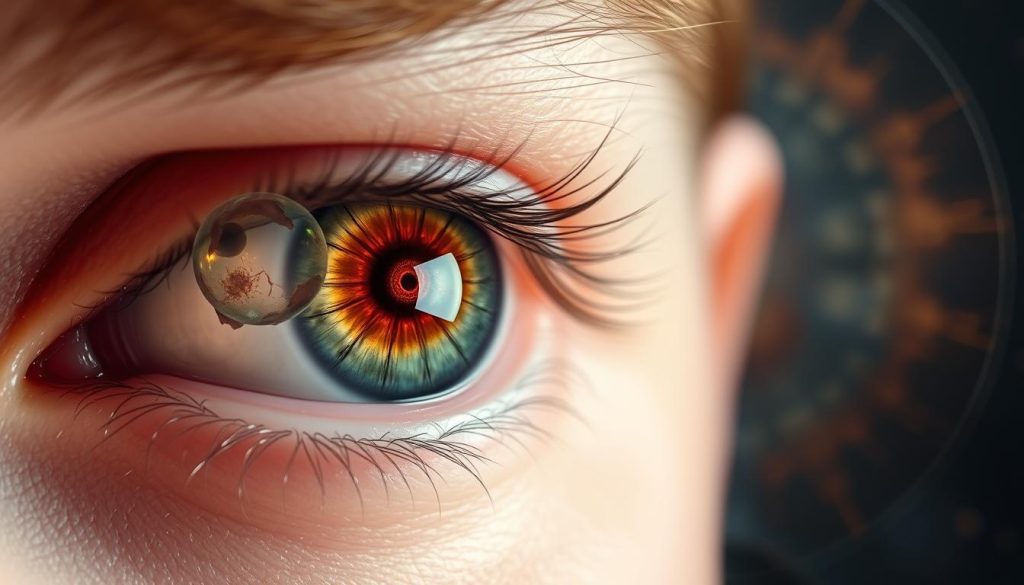
Diagnosing Left Eye Vision Problems
Finding out why you have vision problems in your left eye is key. Doctors use many tools and methods to check your eye’s health. This helps them create a treatment plan just for you.
Types of Vision Tests
Eye exams start with simple tests like the Snellen eye chart. This checks how well you can see. Other tests might include:
- Pupil dilation to look inside the eye
- Color vision tests to see if you can see colors right
- Tests for blind spots or limited sight
- Checks on how well your eyes move and work together
Professional Eye Examinations
Seeing an eye doctor or optometrist is very important. They will do a detailed check. This includes:
- Looking at your medical history for clues
- Checking the outside of your eye
- Using special tools to look inside your eye
- Testing how your eye muscles and coordination work
Advanced Diagnostic Technologies
Doctors might use new imaging tech to see more details. This includes:
| Diagnostic Tool | Purpose |
|---|---|
| Optical Coherence Tomography (OCT) | Shows detailed pictures of inside your eye, like the retina and optic nerve |
| Fundus Photography | Takes clear pictures of the back of your eye, checking the optic nerve, retina, and blood vessels |
| Visual Field Testing | Sees how wide your vision is, spotting blind spots or areas where you can’t see well |
Using all these tools, doctors can find out why you have vision problems in your left eye. Then, they can make a plan to help you see better.
Medical Treatment Options for Weak Left Eye
Fixing left eye vision issues needs a detailed plan. This often includes a mix of treatments. Options range from corrective lenses to vision therapy and surgery. These help make weak left eye sight better.
Corrective Lenses
Corrective lenses like glasses or contacts are a common fix. They correct errors like nearsightedness or astigmatism. An optometrist might suggest different types of lenses based on your needs.
Vision Therapy
Vision therapy is a non-invasive way to improve eye function. It includes exercises to strengthen eye muscles and enhance vision. It’s great for those with binocular vision disorders or left eye issues.
Medications
Medicines might be needed for some vision problems. For example, eye drops or pills can help with certain diseases. Always follow your doctor’s advice when taking medication.
Surgical Interventions
Surgery might be needed for serious vision issues. This could be LASIK for errors or surgeries for specific conditions. Your doctor will decide the best surgery for you.
| Treatment Option | Description | Potential Benefits | Potential Risks |
|---|---|---|---|
| Corrective Lenses | Eyeglasses or contact lenses to correct refractive errors | Improved visual acuity, reduced eye strain, enhanced daily functioning | Possible discomfort, dependency on corrective lenses, potential for further vision deterioration |
| Vision Therapy | Non-invasive exercises and activities to improve eye coordination and function | Strengthened eye muscles, enhanced visual processing, improved binocular vision | Time-consuming, may require professional supervision, limited effectiveness in some cases |
| Medications | Eye drops or oral medications to manage underlying conditions | Reduced inflammation, improved visual function, management of symptoms | Potential side effects, need for regular monitoring, limited effectiveness in some cases |
| Surgical Interventions | Refractive surgery or specialized procedures to address specific eye or neurological conditions | Improved visual acuity, reduced dependence on corrective lenses, potential for long-term vision improvement | Risks associated with surgery, such as infection, scarring, or further vision problems |
Choosing the right treatment for left eye vision problems is crucial. Working with a healthcare expert is key. By exploring different options, you can tackle your eye issues and improve your vision.
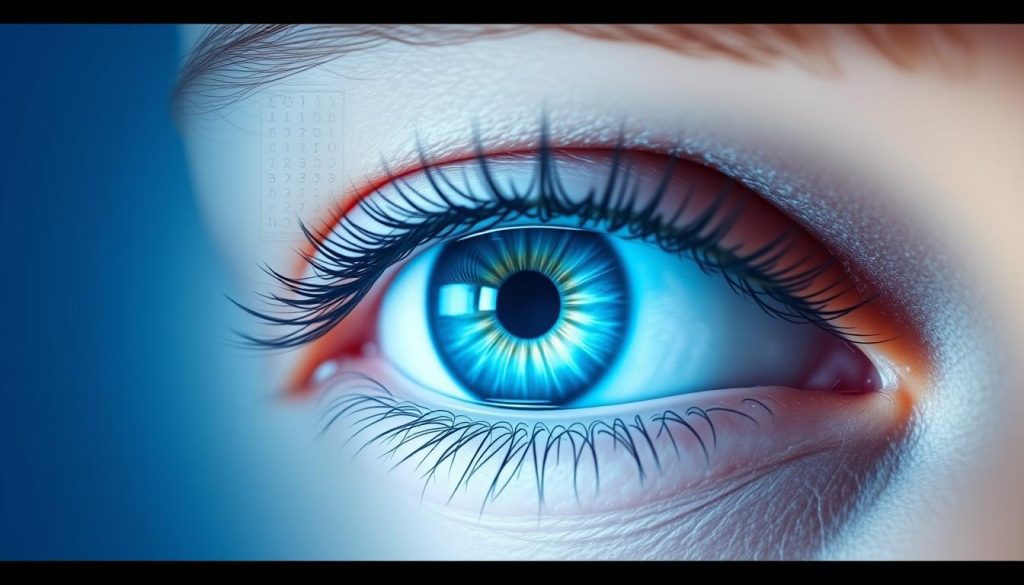
Natural Remedies and Eye Exercises
Improving left eye vision can be helped by natural remedies and eye exercises. These methods aim to strengthen eye muscles and improve eye health. They might also help with vision problems.
Strengthening Eye Muscles
Eye exercises can make eye muscles stronger and more coordinated. Here are some exercises you can try:
- Palming: Gently cover your eyes with your palms, blocking out all light, and focus on relaxing the eyes.
- Figure Eights: Slowly trace figure eights in the air with your eyes, gradually increasing the size of the movements.
- Blink Exercises: Blink your eyes rapidly for a few seconds, then open them wide and hold for a count of five.
Dietary Recommendations
Some nutrients and vitamins are good for eye health and vision. Try to eat more of these foods:
- Leafy greens, such as spinach and kale, which are rich in lutein and zeaxanthin.
- Fatty fish, like salmon and tuna, which are high in omega-3 fatty acids.
- Citrus fruits, bell peppers, and Brussels sprouts, which are excellent sources of vitamin C.
- Nuts and seeds, which contain zinc, a mineral that supports vision problems and eye strain.
Using these natural remedies and eye exercises with regular eye check-ups can support eye health. They might also help with left eye vision issues.
Preventing Further Vision Deterioration
Keeping your eye health in check is crucial, especially if you have low vision or other eye issues. Regular eye exams, wearing protective eyewear, and making smart lifestyle choices can help a lot. These actions can improve or keep your vision sharp.
Getting regular eye check-ups is a must. A good eye doctor or optometrist can spot problems early. They can also create a plan to help your vision problems. Catching issues early is key to keeping your eye health in good shape.
Wearing protective eyewear is another important step. Sunglasses or special lenses that block UV rays can help. They can lower the risk of eye diseases like cataracts and macular degeneration, which can lead to low vision.
Lastly, living a healthy lifestyle is vital for your eye health. Eating well, staying active, and managing health issues like diabetes or high blood pressure are all important. These habits can help prevent more vision problems.
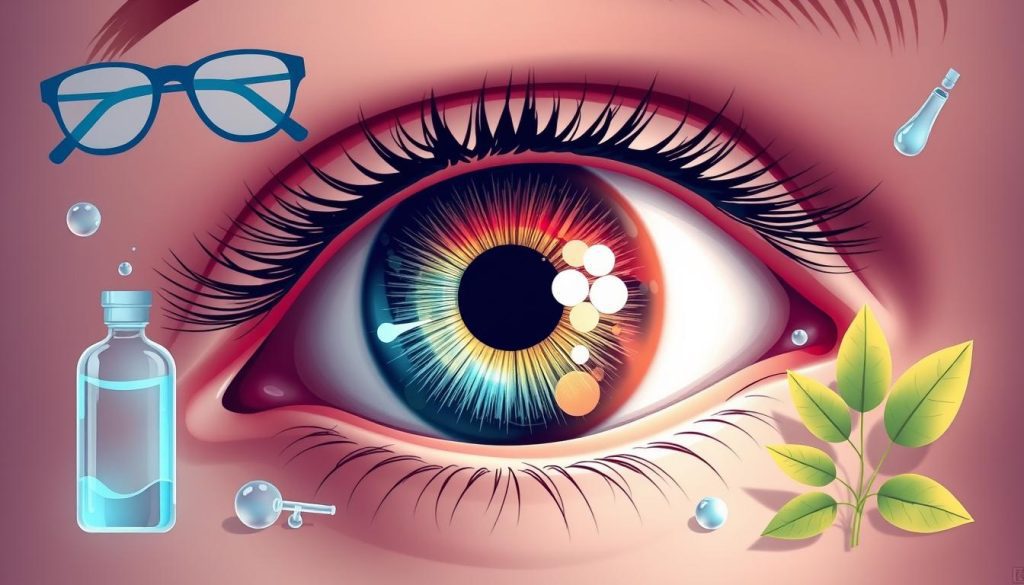
By taking care of your eye health and using preventive steps, you can protect your sight. This is especially true for those with vision problems or low vision. Taking action now can help keep your vision clear for years to come.
Living with Monocular Vision: Adaptation Strategies
Living with monocular vision, where one eye is weak or missing, can be tough. But, with the right steps, people with monocular vision, visual impairment, or low vision can stay independent and live well.
Workplace Accommodations
At work, those with monocular vision might need special help. This can include:
- Adjusting computer screen positions and lighting to minimize glare and eye strain
- Using magnification software or devices to enlarge text and images
- Arranging the workspace to minimize obstacles and improve depth perception
- Exploring assistive technologies, like specialized cameras or scanners, to enhance visual input
Lifestyle Modifications
Outside of work, daily life might need changes too. Some tips include:
- Working on spatial awareness and depth perception through practice and training
- Using safety measures, like handrails and avoiding uneven surfaces, to prevent falls and injuries
- Trying hobbies and activities that fit their visual needs, like sports with clear boundaries
- Getting help from vision rehabilitation specialists or joining support groups to learn from others
By using these adaptation strategies, people with monocular vision can beat their visual challenges. They can stay independent, productive, and enjoy a good quality of life.

“With the right mindset and adaptations, living with monocular vision is not just possible, but can be a fulfilling and empowering experience.”
Latest Research and Treatment Innovations
Researchers and doctors are always looking for new ways to help with left eye vision issues. They are exploring new technologies and treatments. This is a big step forward in eye health for those with vision problems and ocular disorders.
New tools are being developed to better understand left eye vision weakness. These tools include high-resolution imaging and genetic tests. They help doctors find the exact cause of vision problems, leading to better treatments.
Stem cell therapy and gene-based treatments are also being researched. These methods aim to fix or grow new eye tissues. They offer hope for those with few treatment options before.
New, non-invasive therapies are also being developed. These include eye exercises and special supplements. They aim to strengthen eye muscles and improve vision, helping to slow down vision problems.
As research and development grow, there’s hope for better treatments for left eye vision weakness. By keeping up with eye health news, patients and doctors can work together. This helps on the path to better vision and a better life.
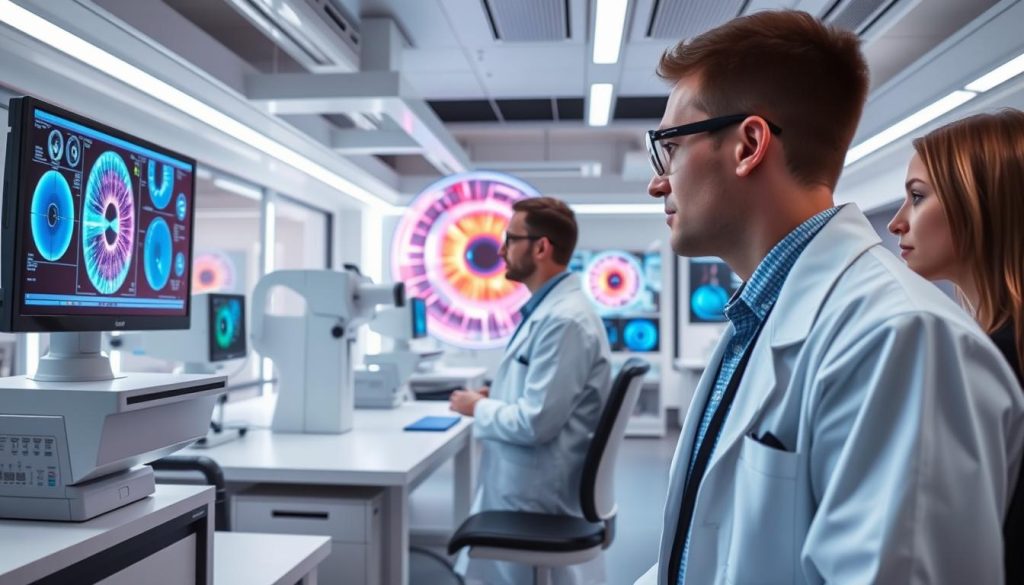
“The future of vision care is truly exciting, with the potential to transform the lives of those living with left eye vision problems.”
Conclusion
Left eye sight weakness can really affect your daily life and well-being. We’ve looked at symptoms, medical conditions, treatments, and natural remedies. We hope this guide has helped you understand and manage your eye health.
It’s important to catch vision problems early and get medical help fast. Working with eye care experts can help you find the right treatment. This could be for a neurological issue, eye disorder, or other factors.
Living a healthy lifestyle and doing eye exercises can help your left eye sight. Being proactive can improve your vision and reduce any limitations. You can look forward to a future with clear, confident sight.
FAQ
What are the common symptoms of left eye vision weakness?
Symptoms include blurred vision, trouble with depth, and eye strain. You might also feel sensitive to light or glare.
How can left eye vision problems impact daily activities?
Weakness in the left eye can make tasks hard, like driving or sports. It also affects reading, computer work, and navigating new places.
When should someone seek medical attention for left eye vision problems?
See a doctor if your vision suddenly changes, you have eye pain, or your left eye doesn’t work well. Quick help from an eye expert is key to finding and treating the cause.
What are some common medical conditions that can lead to left eye vision weakness?
Conditions like amblyopia, cataracts, glaucoma, and retinal detachment can cause weakness. Getting the right treatment is important for your eye health.
How does the brain-eye connection affect vision problems?
The brain and eyes work together for vision. Problems like neurological issues or optic nerve damage can cause vision problems, including weakness in the left eye.
What types of vision tests are used to diagnose left eye vision problems?
Eye exams include tests for vision, pupil checks, and imaging like OCT. These help find the cause of left eye weakness.
What are some medical treatment options for weak left eye vision?
Treatments can be glasses, vision therapy, medicine, or surgery. Your doctor will choose the best option for you.
Are there any natural remedies or eye exercises that can help improve left eye vision?
Yes, eye exercises and diet changes can help. Try eye patching, focusing exercises, and foods rich in lutein and zeaxanthin.
How can individuals with left eye vision weakness prevent further deterioration?
Regular eye exams, protective eyewear, and a healthy lifestyle are key. They help slow down vision problems.
What strategies can help individuals adapt to living with monocular vision due to left eye weakness?
Use workplace aids, assistive tech, and improve spatial awareness. Making lifestyle changes helps maintain independence and quality of life.
What are some of the latest research and treatment innovations for left eye vision problems?
New research includes gene therapy, stem cell treatments, and personalized medicine. These may offer new solutions for left eye vision weakness.